A Novel Composite Index for the Development of Decentralized Food Production, Food Loss, and Waste Management Policies: A Water-Climate-Food Nexus Approach
Abstract
1. Introduction
- (i)
- An omnivorous/Mediterranean (currently) diet could be considered a plant-oriented dietary approach [5]. The Mediterranean diet represents the crystallization of the centuries-old cooking legacies of different civilizations [24], and is considered one of the healthiest dietary models [25]. It is characterized as containing large amounts of fruits, vegetables, whole grains, legumes, moderate amounts of seafood, and small amounts of other meats. Moreover, olive oil is used as the primary oil [6].
- (ii)
- A pescatarian diet includes fish, dairy products, and eggs. In other words, it is a vegetarian diet including fish and seafood [26].
- (iii)
- A vegetarian diet includes cereals, roots, sugar, vegetable oils, vegetables, fruits, pulses, dairy products, and eggs [26].
- (iv)
- A vegan diet is a vegetarian diet excluding dairy products and eggs [26].
2. Methods
3. Case Study
3.1. System Description
3.2. Data Collection and Calculation
3.3. Main Limitations and Assumptions of the Study
4. Results and Discussion
4.1. SDG-Food Index in the Spanish Food Supply Chain
4.2. SDG-Food Index in a Framework of Non-Compliance and Compliance with the Paris Agreement Targets
4.3. SDG-Food Index Regarding Different Diets
5. Conclusions
Author Contributions
Funding
Institutional Review Board Statement
Informed Consent Statement
Data Availability Statement
Acknowledgments
Conflicts of Interest
References
- Shukla, P.R.; Skea, J.; Buendia, E.C.; Masson-Delmotte, V.; Pörtner, H.O.; Roberts, D.C.; Zhai, P.; Slade, R.; Connors, S.; van Diemen, R. (Eds.) Technical Summary. In Climate Change and Land: An IPCC Special Report on Climate Change, Desertification, Land Degradation, Sustainable Land Management, Food Security, and Greenhouse Gas Fluxes in Terrestrial Ecosystems; Intergovernmental Panel on Climate Change: Geneva, Switzerland, 2019. [Google Scholar]
- FAO. Global Food Losses and Food Waste—Extent, Causes and Prevention. 2011. Available online: http://www.fao.org/3/mb060e/mb060e00.htm (accessed on 16 March 2020).
- Ritchie, H.; Roser, M. Environmental Impacts of Food Production. 2020. Available online: https://ourworldindata.org/environmental-impacts-of-food (accessed on 23 March 2020).
- Vora, N.; Shah, A.; Bilec, M.; Khanna, V. Food-energy-water nexus: Quantifying embodied energy and GHG emissions from mitigation through virtual water transfers in food trade. ACS Sustain. Chem. Eng. 2017, 5, 2119–2128. [Google Scholar] [CrossRef]
- Rosi, A.; Mena, P.; Pellegrini, N.; Turroni, S.; Neviani, E.; Ferrocino, I.; Di Cagno, R.; Ruini, L.; Ciati, R.; Angelino, D.; et al. Environmental impact of omnivorous, ovo-lacto-vegetarian and vegan diet. Nat. Sci. Rep. 2017, 7, 6105. [Google Scholar] [CrossRef] [PubMed]
- Clark, M.; Hill, J.; Tilman, D. The Diet, Health, and Environmental Trilemma. Annu. Rev. Environ. Resour. 2018, 43, 109–134. [Google Scholar] [CrossRef]
- Gustavsson, J.; Cederberg, C.; Sonesson, U.; van Otterdijk, R.; Meybeck, A. Global Food Losses and Food Waste: Extent, Causes and Prevention; FAO: Rome, Italy, 2011. [Google Scholar]
- Guijarro, F.; Poyatos, J.A. Designing a Sustainable Development Goal Index through a Goal Programming Model: The Case of EU-28 Countries. Sustainability 2018, 10, 3167. [Google Scholar] [CrossRef]
- Diaz-Sarachaga, J.M.; Jato-Espino, D.; Castro-Fresno, D. Is the Sustainable Development Goals (SDG) index an adequate framework to measure the progress of the 2030 Agenda? J. Sustain. Dev. 2018, 26, 663–671. [Google Scholar] [CrossRef]
- Jabbari, M.; Shafiepour-Motlagh, M.; Ashrafi, K.; Abdoli, G. Differentiating countries based on the sustainable development proximities using the SDG indicators. Environ. Dev. Sustain. 2019, 22, 6405–6423. [Google Scholar] [CrossRef]
- Kynčlová, P.; Upadhyaya, S.; Nice, T. Composite index as a measure on achieving Sustainable Development Goal 9 (SDG-9) industry-related targets: The SDG-9 index. Appl. Energy 2020, 265, 114755. [Google Scholar] [CrossRef]
- Lemke, C.; Bastinit, K. Embracing multiple perspectives of sustainable development in a composite measure: The Multilevel Sustainable Development Index. J. Clean. Prod. 2020, 246, 118884. [Google Scholar] [CrossRef]
- Moreno, B.; García-Álvarez, M.T. Measuring the progress towards a resource-efficient European Union under the Europe 2020 strategy. J. Clean. Prod. 2018, 170, 991–1005. [Google Scholar] [CrossRef]
- Alaimo, L.S.; Maggino, F. Sustainable Development Goals Indicators at Territorial Level: Conceptual and Methodological Issues—The Italian Perspective. Soc. Indic. Res. 2020, 147, 383–419. [Google Scholar] [CrossRef]
- Redlingshöfer, B.; Barles, S.; Weisz, H. Are waste hierarchies effective in reducing environmental impacts from food waste? A systematic review for OECD countries. Resour. Conserv. Recycl. 2020, 156, 104723. [Google Scholar] [CrossRef]
- Pérez-Escamilla, R. Food Security and the 2015–2030 Sustainable Development Goals: From Human to Planetary Health, Perspectives and Opinions; Department of Social and Behavioral Sciences and Global Health Concentration, Yale School of Public Health: New Haven, CT, USA, 2020. [Google Scholar]
- Agovino, M.; Cerciello, M.; Gatto, A. Policy efficiency in the field of food Sustainability. The adjusted food agricultura and nutrition index. J. Environ. Manag. 2018, 218, 220–233. [Google Scholar] [CrossRef] [PubMed]
- Azzura, A.; Massimiliano, A.; Angela, M. Measuring sustainable food consumption: A case study on organic food. Sustain. Prod. Consum. 2019, 17, 95–107. [Google Scholar] [CrossRef]
- Saladini, F.; Betti, G.; Ferragina, E.; Bouraoui, F.; Cupertino, S.; Canitano, G.; Gigliotti, M.; Autino, A.; Pulselli, F.M.; Riccaboni, A.; et al. Linking the water-energy-food nexus and sustainable development indicators for the Mediterranean region. Ecol. Indic. 2018, 91, 689–697. [Google Scholar] [CrossRef]
- Kurian, M.; Scott, C.; Ratna-Reddy, V.; Alabaster, G.; Nardocci, A.; Portney, K.; Boer, R.; Hannibal, B. One Swallow Does Not Make a Summer: Siloes, Trade-Offs and Synergies in the Water-Energy-Food Nexus. Front. Environ. Sci. 2019, 7, 32. [Google Scholar] [CrossRef]
- Laso, J.; Margallo, M.; García-Herrero, I.; Fullana, P.; Bala, A.; Gazulla, C.; Polettini, A.; Kahhat, R.; Vázquez-Rowe, I.; Irabien, A.; et al. Combined application of Life Cycle Assessment and linear programming to evaluate food waste-to-food strategies: Seeking for answers in the nexus approach. Waste Manag. 2018, 80, 186–197. [Google Scholar] [CrossRef]
- Leivas, R.; Laso, J.; Abejón, R.; Margallo, M.; Aldaco, R. Environmental assessment of food and beverage under a NEXUS Water-Energy-Climate approach: Application to the spirit drinks. Sci. Total Environ. 2020, 720, 137576. [Google Scholar] [CrossRef]
- United Nations. Adoption of the Paris Agreement. 2015. Available online: https://unfccc.int/resource/docs/2015/cop21/eng/l09r01.pdf (accessed on 20 November 2020).
- Hidalgo-Mora, J.J.; García-Vigara, A.; Sánchez-Sánchez, M.L.; García-Pérez, M.A.; Tarín, J.; Cano, A. The Mediterranean diet: A historical perspective on food for health. Maturitas 2020, 132, 65–69. [Google Scholar] [CrossRef]
- Zani, C.; Ceretti, E.; Grioni, S.; Viola, G.C.V.; Donato, F.; Feretti, D.; Festa, A.; Bonizzoni, S.; Bonetti, A.; Monarca, S.; et al. MAPEC-LIFE Study Group, Are 6–8 year old Italian children moving away from the Mediterranean diet? Ann. Ig. 2016, 28, 339–348. [Google Scholar] [PubMed]
- Guinée, J.B.; Gorrée, M.; Heijungs, R.; Huppes, G.; Kleijn, R.; Koning, A.; Van Oers, L.; Sleeswijk, A.W.; Suh, S.; De Haes, H.A.U.; et al. Handbook on Life Cycle Assessment. Operational Guide to the ISO Standards. I: LCA in Perspective. IIa: Guide. IIb: Operational Annex. III: Scientific Background; Kluwer Academic Publishers: Dordrecht, The Netherlands, 2002; ISBN 1-4020-0228-9. [Google Scholar]
- Guinée, J.B. Selection of Impact Categories and Classification of LCI. Results to Impact Categories. In Life Cycle Impact Assessment, 1st ed.; Guinée, J.B., Ed.; Springer: Dordrecht, The Netherlands, 2017; pp. 17–37. [Google Scholar]
- Garcia-Herrero, I.; Hoehn, D.; Margallo, M.; Laso, J.; Bala, A.; Balle-Bayer, L.; Fullana, P.; Vazquez-Rowe, I.; Gonzalez, M.J.; Durá, M.J.; et al. On the estimation of potential food waste reduction to support sustainable production and consumption policies. Food Policy 2018, 80, 24–38. [Google Scholar] [CrossRef]
- Batlle-Bayer, L.; Aldaco, R.; Bala, A.; Fullana-i-Palmer, P. Towards sustainable dietary patterns under a water-energy-food nexus life cycle thinking approach. Curr. Opin. Environ. Sci. Health 2020, 13, 61–67. [Google Scholar] [CrossRef]
- Chapagain, A.; James, K. Accounting for the Impact of Food Waste on Water Resources and Climate Change. Food Ind. Wastes 2013, 217–236. [Google Scholar] [CrossRef]
- Hoekstra, A.Y.; Chapagain, A.K.; Aldaya, M.M.; Mekonnen, M.M. The Water Footprint Assessment Manual: Setting the Global Standard; Earthscan: London, UK, 2011. [Google Scholar]
- OECD. Handbook on Constructing Composite Indicators. Methodology and User Guide; OECD: Paris, France, 2008; ISBN 978-92-64-04345-9.
- Infante-Amate, J.; Gonzalez de Molina, M. “Sustainable de-growth” in agriculture and food: An agro-eological perspective on Spain´s agri-food system (year 2000). J. Clean. Prod. 2013, 38, 27–35. [Google Scholar] [CrossRef]
- FAO. Definitional Framework of Food Loss, Working Paper. 2014. Available online: http://www.fao.org/fileadmin/user_upload/save-food/PDF/FLW_Definition_and_Scope_2014.pdf (accessed on 19 February 2020).
- Aldaco, R.; Butnar, I.; Margallo, M.; Laso, J.; Rumayor, M.; Dominguez-Ramos, A.; Irabien, A.; Dodds, P.E. Bringing value to the chemical industry from capture, storage and use of CO2: A dynamic LCA of formic acid production. Sci. Total Environ. 2019, 663, 738–753. [Google Scholar] [CrossRef]
- Anandarajah, G.; Pye, S.; Ushner, W.; Kesicki, F.; Mcglade, C. TIAM-UCL Global Model Documentation; Working Paper, REF UKERC/WP7ESY/2011/001. 2011. Available online: https://www.ucl.ac.uk/drupal/site_energy-models/sites/energy-models/files/tiam-ucl-manual.pdf (accessed on 21 November 2020).
- Hoehn, D.; Margallo, M.; Laso, J.; García-Herrero, I.; Bala, A.; Fullana-i-Palmer, P.; Irabien, A.; Aldaco, R. Energy Embedded in Food Loss Management and in the Production of Uneaten Food: Seeking a Sustainable Pathway. Energies 2019, 12, 767. [Google Scholar] [CrossRef]
- Sphera. Gabi 6 Software and Database on Life Cycle Assessment; Sphera: Chicago, IL, USA, 2020.
- Gustavsson, J.; Cederberg, C.; Sonesson, U.; Emanuelsson, A. The Methodology of the FAO Study: “Global Food Losses and Food Waste-Extent, Causes and Prevention”—FAO, 2011; The Swedish Institute for Food and Biotechnology (SIK): Göteborg, Sweden, 2013. [Google Scholar]
- Vinyes, E.; Asin, L.; Alegre, S.; Muñoz, P.; Boschmonart, J.; Gasol, C.M. Life Cycle Assessment of Apple and peach production, distribution and consumption in Mediterranean fruit sector. J. Clean. Prod. 2017, 149, 313–320. [Google Scholar] [CrossRef]
- Riobás, L.; Elbehri, A.; Hospido, A. Carbon footprint along the Ecuadorian banana supply chain: Methodological improvements and calculation tool. J. Clean. Prod. 2016, 112, 2441–2451. [Google Scholar] [CrossRef]
- Ministry of Agriculture, Fishery, Food and Environment; MAPAMA. Informes de Consumo de Alimentación en España; MAGRAMA: Madrid, Spain, 2015.
- Arcadis Project Number—11/004759, Version C, Assessment of the Options to Improve the Management of Biowaste in the European Union—Final Report, European Commission DG Environment. 2010. Available online: https://ec.europa.eu/environment/waste/compost/pdf/ia_biowaste%20-%20final%20report.pdf (accessed on 24 March 2020).
- Hoehn, D.; Laso, J.; Cristóbal, J.; Butnar, I.; Borrion, A.; Bala, A.; Fullana-i-Palmer, P.; Vázquez-Rowe, I.; Aldaco, R.; Margallo, M. Regionalized Strategies for Food Loss Management in Spain under a Life Cycle Thinking Approach. Foods 2020, 9, 1765. [Google Scholar] [CrossRef]
- Riege, A.M. Validity and reliability tests in case study research: A literature review with “hands-on” applications for each research phase. Qual. Mark. Res. Int. J. 2003, 6, 75–86. [Google Scholar] [CrossRef]
- Ringler, C.; Bhaduri, A.; Lawford, R. The nexus across water, energy, land and food (WELF): Potential for improved resource use efficiency? J. Environ. Sustain. 2013, 5, 617–624. [Google Scholar] [CrossRef]
- FAO. The State of Food and Agriculture 2019, Moving Forward on Food Loss and Waste Reduction; FAO: Rome, Italy, 2019.
- Aldaco, R.; Hoehn, D.; Laso, J.; Margallo, M.; Ruiz-Salmón, I.; Cristobal, J.; Kahhat, R.; Villanueva-Rey, P.; Bala, A.; Batlle-Bayer, L.; et al. Food waste management during the COVID-19 outbreak: A holistic climate, economic and nutritional approach. Sci. Total Environ. 2020, 742, 140524. [Google Scholar] [CrossRef] [PubMed]
- Chen, C.; Chaudhary, A.; Mathys, A. Nutritional and environmental losses embedded in global food waste. Resour. Conserv. Recy. 2020, 160, 104912. [Google Scholar] [CrossRef]
- Laso, J.; Campos, C.; Fernández-Ríos, A.; Hoehn, D.; del Río, A.; Ruiz-Salmón, I.; Cristóbal, J.; Quiñones, A.; Amo-Setién, F.J.; Ortego, M.C.; et al. Looking for Answers to Food Loss and Waste Management in Spain from a Holistic Nutritional and Economic approach. Sustainability 2021, 13, 125. [Google Scholar] [CrossRef]
- Sachs, J.; Schmidt-Traub, G.; Kroll, C.; Lafortune, G.; Fuller, G.; Woelm, F. The Sustainable Development Goals and COVID-19, Sustainable Development Report 2020; Cambridge University Press: Cambridge, UK, 2020. [Google Scholar]
- Doelman, J.; Stehfest, E.; Tabeau, A.; Van Meijl, H. Making the Paris agreement climate targets consistent with food security objectives. Glob. Food Sec. 2019, 23, 103. [Google Scholar] [CrossRef]
- Hoehn, D.; Laso, J.; Margallo, M.; Ruíz-Salmón, I.; Quiñones, A.; Amo-Setién, F.A.; Vázquez-Rowe, I.; Bala, A.; Batlle-Bayer, L.; Fullana-i-Palmer, P.; et al. Introducing a Degrowth Approach to the Circular Economy Policies of Food Production and Food Loss and Waste Management: Towards a Circular Bioeconomy. Sustainability 2021, in press. [Google Scholar]
- Sabaté, J.; Soret, S. Sustainability of plant-based diets: Back to the future. Am. J. Clin. Nutr. 2014, 100 (Suppl. 1), 476S–482S. [Google Scholar] [CrossRef]
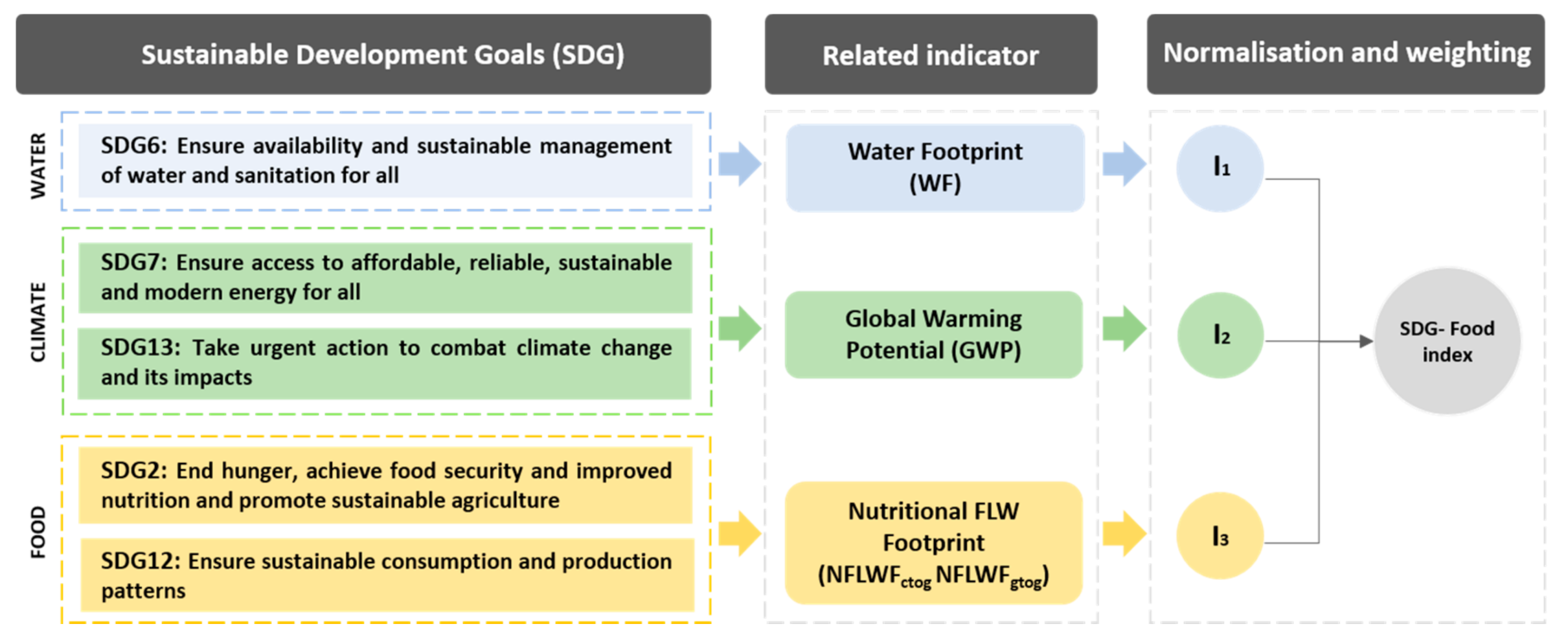
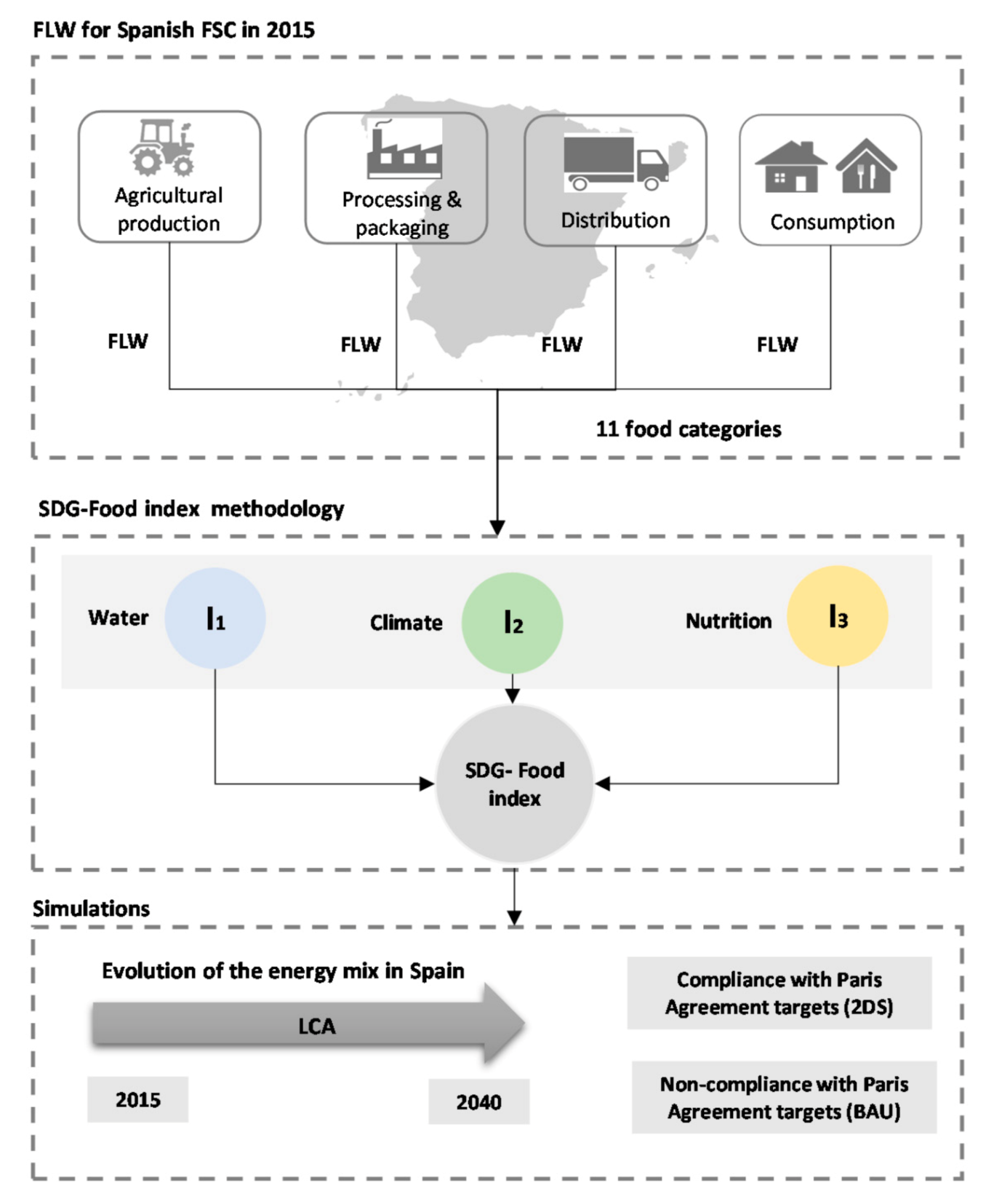
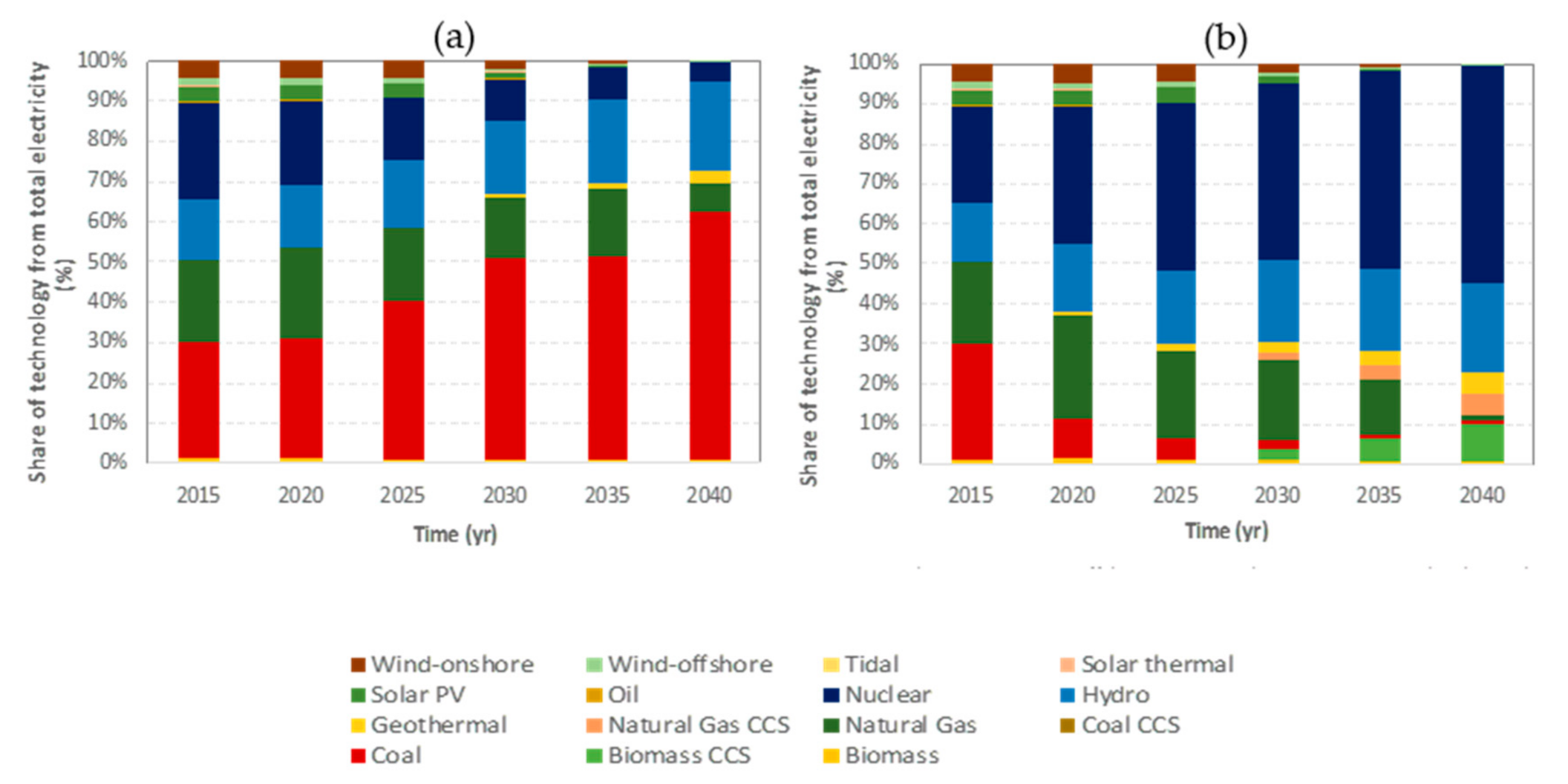
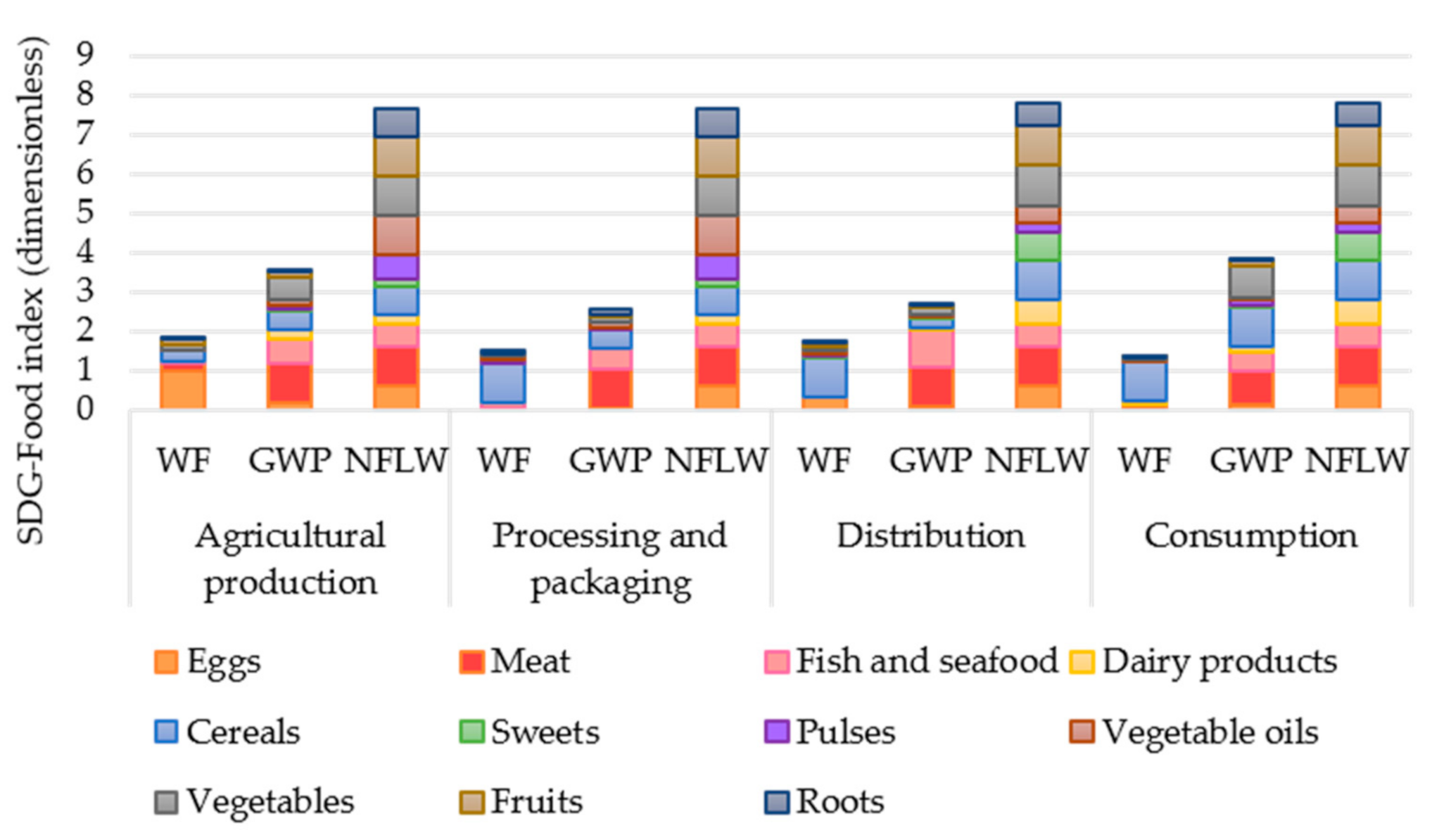
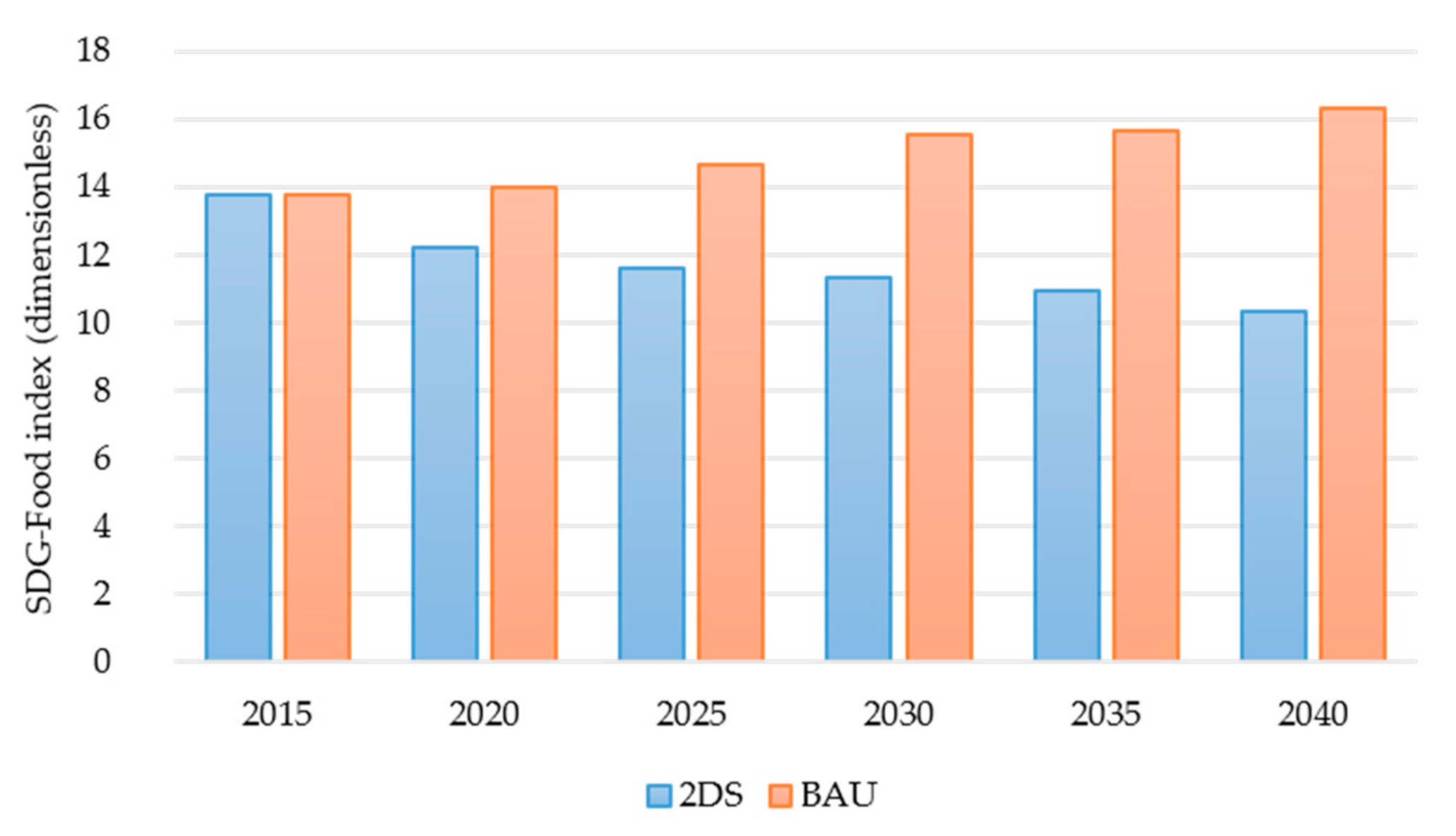
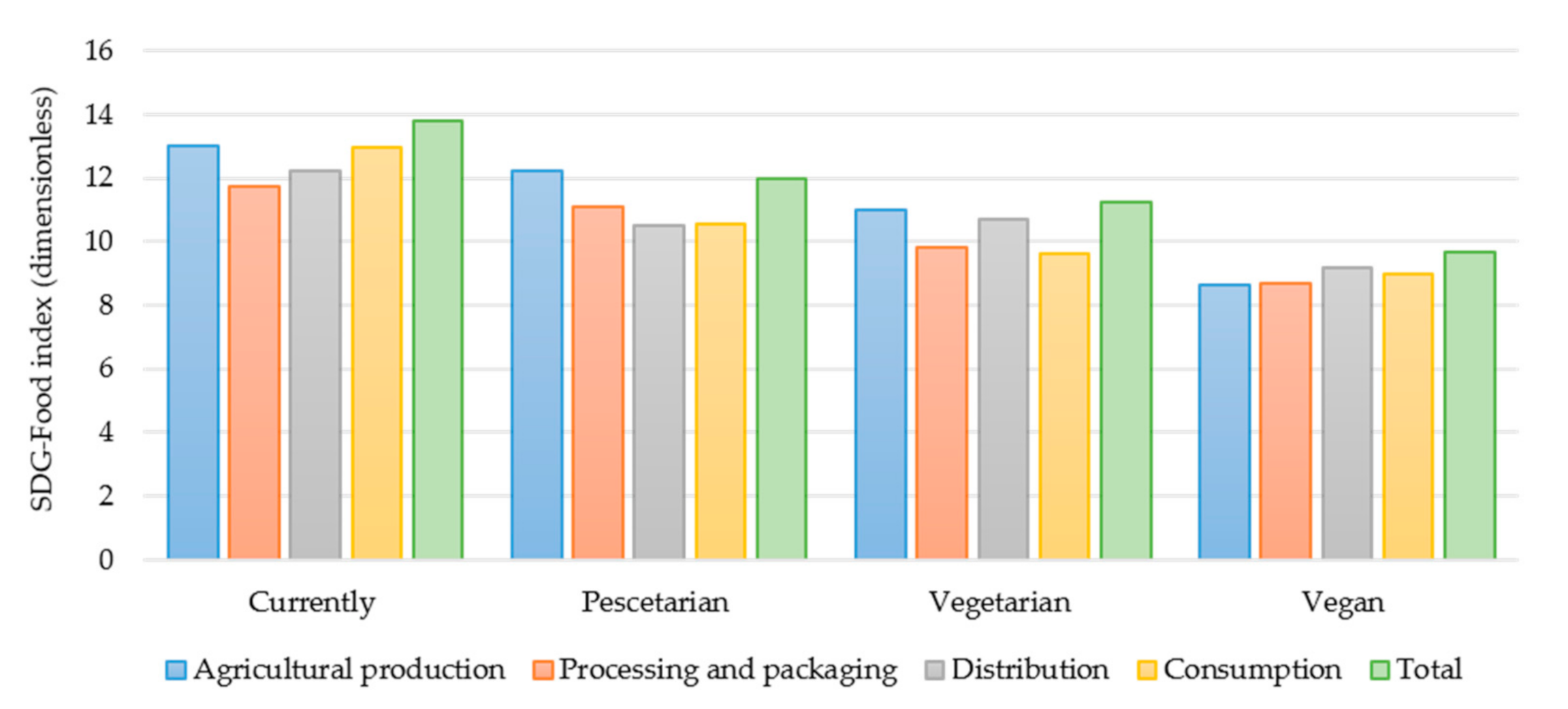
| Food Category | WF (kg of Water/Ton FLW) |
|---|---|
| Eggs | 458.9 |
| Meat | 665.1 |
| Fish and seafood | 413.0 |
| Dairy products | 435.3 |
| Cereals | 523.0 |
| Sweets | 234.2 |
| Pulses | 134.3 |
| Vegetable oils | 1517.0 |
| Vegetables | 214.1 |
| Fruits | 220.2 |
| Roots | 168.2 |
| Total | 4983.4 |
| Food Category | WF (SDG6) | GWP (SDG7, SDG13) | NFLWF (SDG2, SDG12) | |
|---|---|---|---|---|
| I1 | I2 | I3 | IT | |
| Eggs | 1.00 | 0.12 | 0.60 | 1.72 |
| Meat | 0.20 | 1.00 | 1.00 | 2.20 |
| Fish and seafood | 0.05 | 0.62 | 0.60 | 1.26 |
| Dairy products | 0.04 | 0.13 | 0.40 | 0.57 |
| Cereals | 0.72 | 0.80 | 0.87 | 2.39 |
| Sweets | 0.01 | 0.03 | 0.47 | 0.51 |
| Pulses | 0.01 | 0.10 | 0.40 | 0.51 |
| Vegetable oils | 0.02 | 0.06 | 0.73 | 0.82 |
| Vegetables | 0.13 | 0.64 | 1.00 | 1.77 |
| Fruits | 0.13 | 0.13 | 1.00 | 1.26 |
| Roots | 0.03 | 0.07 | 0.67 | 0.76 |
| Total | 2.36 | 3.70 | 7.73 | 13.79 |
| Stages | WF (SDG6) | GWP (SDG7, SDG13) | NFLWF (SDG2, SDG12) | SDG-Food Index |
|---|---|---|---|---|
| I1 | I2 | I3 | IT | |
| Agricultural production | 1.79 | 3.57 | 7.66 | 13.02 |
| Processing and packaging | 1.49 | 2.58 | 7.66 | 11.73 |
| Distribution | 1.77 | 2.66 | 7.80 | 12.23 |
| Consumption | 1.33 | 3.86 | 7.80 | 12.99 |
| Total | 2.36 | 3.70 | 7.73 | 13.79 |
Publisher’s Note: MDPI stays neutral with regard to jurisdictional claims in published maps and institutional affiliations. |
© 2021 by the authors. Licensee MDPI, Basel, Switzerland. This article is an open access article distributed under the terms and conditions of the Creative Commons Attribution (CC BY) license (http://creativecommons.org/licenses/by/4.0/).
Share and Cite
Hoehn, D.; Margallo, M.; Laso, J.; Ruiz-Salmón, I.; Batlle-Bayer, L.; Bala, A.; Fullana-i-Palmer, P.; Aldaco, R. A Novel Composite Index for the Development of Decentralized Food Production, Food Loss, and Waste Management Policies: A Water-Climate-Food Nexus Approach. Sustainability 2021, 13, 2839. https://doi.org/10.3390/su13052839
Hoehn D, Margallo M, Laso J, Ruiz-Salmón I, Batlle-Bayer L, Bala A, Fullana-i-Palmer P, Aldaco R. A Novel Composite Index for the Development of Decentralized Food Production, Food Loss, and Waste Management Policies: A Water-Climate-Food Nexus Approach. Sustainability. 2021; 13(5):2839. https://doi.org/10.3390/su13052839
Chicago/Turabian StyleHoehn, Daniel, María Margallo, Jara Laso, Israel Ruiz-Salmón, Laura Batlle-Bayer, Alba Bala, Pere Fullana-i-Palmer, and Rubén Aldaco. 2021. "A Novel Composite Index for the Development of Decentralized Food Production, Food Loss, and Waste Management Policies: A Water-Climate-Food Nexus Approach" Sustainability 13, no. 5: 2839. https://doi.org/10.3390/su13052839
APA StyleHoehn, D., Margallo, M., Laso, J., Ruiz-Salmón, I., Batlle-Bayer, L., Bala, A., Fullana-i-Palmer, P., & Aldaco, R. (2021). A Novel Composite Index for the Development of Decentralized Food Production, Food Loss, and Waste Management Policies: A Water-Climate-Food Nexus Approach. Sustainability, 13(5), 2839. https://doi.org/10.3390/su13052839










